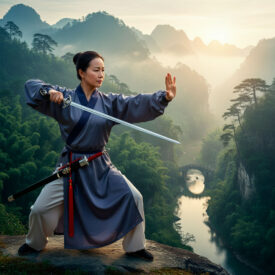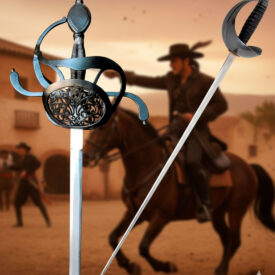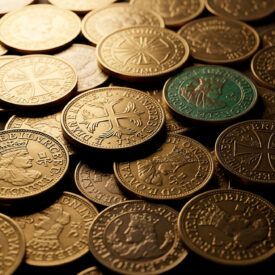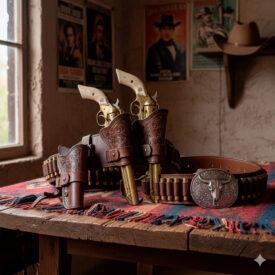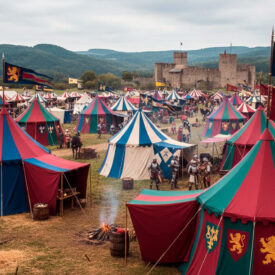A blade can be much more than metal: it can embody honor, strategy and poetry. From the thunderous forges of Longquan to the choreographies of modern wǔshù, Chinese swords have crossed millennia to become complex symbols of skill, status and aesthetics. What distinguishes the Jian from the Dao? How did Chinese metallurgy influence their development? This article will guide you, with detail and passion, through the history, forging techniques, types, and contemporary use of these weapons that are at once martial tools and objects of reverence.
Essential chronology: a quick journey through the eras
Before diving into technical features and forging, let us place the milestones that marked the evolution of Chinese swords. This summarized timeline will help you understand why certain shapes appeared in some periods and disappeared in others, and how the military, cultural and technological spheres intertwined.
| Period | Event |
|---|---|
| Pre-dynastic era and early records | |
| Shang Dynasty (approx. 1600–1100 BC) | Use of bronze in weapons; hints of knives and curved weapons appear. Legends are attributed to the earliest ritual blades. |
| Western Zhou Dynasty (1046–781 BC) | The Jian appears as a secondary military weapon; halberds are used and thrusting techniques are incorporated. |
| Spring and Autumn Period (770–476 BC) | Metallurgical improvements: longer, tougher Jian; increased quality in casting and finishing. |
| Period of development and change (Warring States to Tang) | |
| Warring States Period (~300 BC) | Peak of bronze sword technology; legends about master swords begin to emerge. |
| Qin Dynasty (221–206 BC) | Mass production and standardization for processions and armies; the Jian gains strong presence among military elites. |
| Han Dynasty (206 BC–220 AD) | Gradual military replacement of the Jian by the Dao; more sophisticated tempering and hardening processes appear. |
| Song Dynasty (960–1279) | The Dao diversifies; variants for cavalry and infantry troops appear. Gunpowder and cavalry influence designs. |
| Ming Dynasty (1368–1644) | The Jian consolidates as a civil and ritual symbol; the Dao remains a weapon of war. Forging center: Longquan gains reputation. |
| Modern era | Cultural revaluation in martial arts, film and collecting; archaeological discoveries like the Goujian sword confirm ancient mastery. |
- Shang Dynasty
-
- Period: 1600–1100 BC.
- Fact: Use of bronze and earliest ritual blades.
- Zhou Dynasty
-
- Period: 1046–256 BC.
- Fact: Presence of the Jian as a thrusting weapon.
What do we mean by “Chinese swords”?
The term groups a wide variety of blades with diverse purposes and designs. At its historical core two main families coexist: the Jian (straight sword, double-edged) and the Dao (sabre, single-edged). Beyond that division, there are variants by length, use (training, ceremony, mounted combat) and forging technique. Throughout the text we will see how each technical feature links with martial philosophy and the sword’s social function.
The Jian: the knight’s blade
Shape and philosophy. The Jian is a straight, double-edged sword traditionally associated with elegance, precision and technical mastery. Its use demands prolonged training; that is why it became a symbol of the educated class, representing the balance between the civil (wén) and the martial (wǔ).
Origin and technical evolution
From its early bronze prototypes to high-carbon steel blades, the Jian evolved according to tactical needs and metallurgical advances. Some pieces pay tribute to noble materials: historical records show ceremonial examples carved in jade or inlaid with precious metals.
Tactics and fencing technique
The Jian favors the thrust and precision; its techniques are based on center control, quick hands and economy of movement. In martial arts like Taijiquan the Jian is used to develop sensitivity, coordination and control of the body’s center.
The Jian as symbol
Beyond combat, the Jian was an emblem of status and ritual. In numerous dynasties, carrying a well-crafted Jian indicated social position and education. In Chinese literary and poetic imagery, the sword appears as a metaphor for moral rectitude and purity of intent.
The Dao: the battlefield sabre
Design and purpose. The Dao is, in essence, a weapon conceived for effective cutting. With greater mass and often curvature, it allowed devastating blows and adaptations for cavalry. Its design facilitated mass production and reduced the training time needed for its use.
History and variants
The shift toward the Dao responds to tactical factors: the need for tougher blades, cavalry use and ease of maintenance in campaign. From this arose famed forms like the Liuyedao, the Yanmaodao and the imposing Dadao. Each variant serves a specific function: cutting from the saddle, harassing formations or equipping troops with a reliable and simple weapon.
The Dao in popular culture
The Dao is often the weapon of the most brutal and direct narratives, the blade that settles confrontations decisively. In literature and film, its presence underscores ferocity and warrior pragmatism; in the martial arts, Dao training develops power, timing and physical commitment.
Jian vs Dao: a comparative table
To better understand the technical and cultural differences between the two families, this table compares key parameters of each type.
| Type | Blade length (approx.) | Number of edges | Tactical use |
|---|---|---|---|
| Jian | 60–80 cm | Double-edged | Precision, thrusting, refined technique; symbol of scholarship. |
| Dao | 60–100+ cm (varies) | Single-edged | Powerful cuts, mounted combat, durability and mass production. |
- Jian
-
- Length: 60–80 cm.
- Feature: Double-edged, thrusting and technique.
- Dao
-
- Length: 60–100+ cm.
- Feature: Single edge, designed to cut and withstand impacts.
Forging: materials, techniques and masters
If we understand the sword as the sum of design, material and temper, forging appears as the heart that gives character to each blade. Chinese tradition developed remarkable methods long before the modern era, with folding techniques, alloy combinations and heat treatments that persist in technical memory.
Notable historical techniques
- Bailiangang (百炼钢): repeated folding and hammering to obtain steel balanced between hardness and ductility.
- Chaogang (炒钢): carburization/reducing/puddling processes in regions like Yunnan.
- Use of alloys: bronze casting with a tin finish to improve edge retention and corrosion resistance.
The famous Goujian Sword, recovered virtually intact after more than 2,500 years, is archaeological proof that Chinese metallurgy reached masterful levels. That sword challenges those who doubt ancient technical ability and remains an object of study for its extraordinary composition and preservation.
Longquan: the city of masters
Longquan has long been an epicenter of blade manufacture in China. There, craftsmen continued to pass down traditional techniques generation after generation, mixing ancestral knowledge with modern needs (functional replicas, ceremonial pieces and blades for wǔshù).
Contemporary use and martial practices
Today Chinese swords coexist in three main spheres: martial practice (wǔshù, taijiquan), collecting/aesthetics and cultural representation (film, theatre). Each approach requires different finishes: from a functional blade for cutting to an ornamental replica for display.
In martial practice, the choice between Jian and Dao responds to different goals. The Jian develops precision and sensitivity; the Dao enhances power and timing. Both, however, require respect for safety and maintenance.
Products and replicas: framing the historical in the modern
Modern replicas seek to balance historical authenticity and safety standards. There are pieces intended for practice (tempered and sharpened blades for cutting tests) and others aimed at stage or decoration (treated steels lightly sharpened or unsharpened).
Clearing up your questions about Chinese swords
What is the main difference between the Jian and the Dao?
The main difference between the Jian and the Dao is that the Jian is a straight, double-edged sword designed primarily for thrusting and precise cutting, while the Dao is a sabre with a generally curved, single-edged blade optimized for cuts and slashes, particularly effective in mounted combat. In short, the Jian is a straight, double-edged sword, and the Dao is a curved, single-edged sabre.
What combat techniques are used with the Jian?
Combat techniques with the Jian are based on circular and evasive movements, combining quick cuts, precise thrusts and fluid footwork to attack and defend simultaneously. Emphasis is placed on speed, precision, control of space and smooth transitions between offense and defense, as well as using the point for pokes and the whole blade for cuts. Physical conditioning is also heavily trained to develop endurance, speed and tense postures that enhance combat effectiveness.
How has sword production in China evolved throughout history?
Sword production in China evolved from the Bronze Age with bronze Jian swords to advanced metallurgical techniques for forging high-carbon steel. Initially, molds were used to cast bronze swords, evolving into complex forging and repeated folding techniques to improve steel quality, such as the “Bailiangang” method, which can involve up to 50 folds to create a resilient and flexible blade. These processes included many reheatings, hammerings and tempers to remove impurities and achieve the ideal balance between hardness and flexibility.
Over time, production incorporated high-quality laminated steel, allowing for longer, thinner and more manageable blades. Later, the Industrial Revolution introduced mass production and new materials, facilitating standardized manufacture of training swords and widening access to these weapons. Thus production moved from highly specialized artisanal works to more efficient industrial manufacturing while maintaining quality and authenticity in the process. Throughout history, Chinese swords have been not only functional weapons but also symbols of power and tradition.
What materials are used to make Chinese swords?
Chinese swords are primarily made from high-quality steel, with Damascus steel among the most used for its combination of strength, hardness and beauty. These steels provide durability and functionality to the sword blade and are often accompanied by traditional finishes that enhance their aesthetic and symbolic value. The handle and other components can be made from appropriate materials to balance the sword and facilitate handling. In summary, the base is strong steel, especially Damascus steel, to achieve both performance and visual appeal.
What role do Chinese swords play in modern martial arts?
Chinese swords play a fundamental role in modern Chinese martial arts such as Wushu and Tai Chi, where they are used not only for combat but also to develop coordination, technique and a deep connection between the practitioner and the weapon. They are also essential elements in competitions, demonstrations and the preservation of the historical cultural legacy of these disciplines. These swords, both the Dao (curved sabre) and the Jian (straight, double-edged sword), represent fighting styles and philosophies that combine technique, aesthetics and tradition in contemporary martial arts. They are valued both for their functionality and for their symbolism within Chinese martial and cultural practice.
Keys to preserving a traditional sword
A well-preserved blade keeps its history and utility. Always keep the sword clean, oiled and in a dry environment. Avoid handling the blade frequently with bare hands: moisture and skin salts promote corrosion. For antique or collectible pieces, consult a professional conservator before any intervention.
Summary of why Chinese swords matter today
Chinese swords are a bridge between technique and symbol. They teach about military evolution, metallurgical technique and cultural aesthetics. In martial practice they develop skills ranging from precision to body control; in popular culture they maintain a presence that evokes honor and drama. Knowing their history and technique allows you to appreciate them beyond their mere appearance.
DADAO SWORDS | DAO SWORDS | JIAN SWORDS | KUNGFU SWORDS | SEE ALL CHINESE SWORDS


